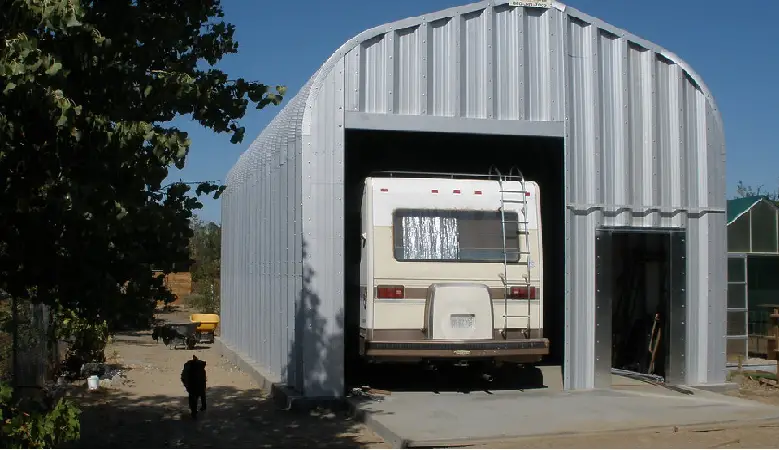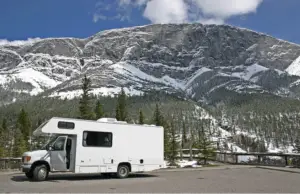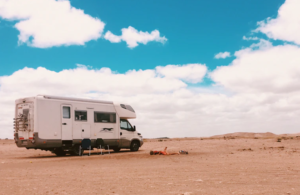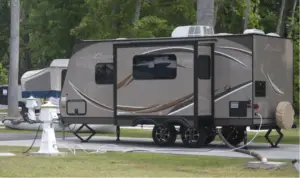Regardless of the kind of adventurer you are, be it sporadic or seasonal, there is always that time when a camper remains dormant until it calls for another trip.
RVs are stored at the owner’s home, campgrounds or storage facilities. The unit can be parked outdoors, sit outdoors, or be tucked under a covered RV storage space.
For most campers, this storage intermission lasts six months or more in a year. To protect this recreational investment, it is essential to consider storing it when not in use.
However, it does not involve forking over a bit of dough without if you need optimal alternatives.
What is covered RV storage?
Covered RV storage refers to construction that offers an overhead or canopy shelter for a camper in storage.
Although these carport-constructions cannot block out all elements from reaching your trailer, they prevent harsh hail, sun, rain, and snow from affecting your camper.
Most storage facilities offer covered camper storage space for rent, though RVers prefer to construct their camper housing structure on their residential areas.
Pros of covered RV storage
There are lots of benefits that accrue from having covered camper storage. They include,
Protection against harsh environmental elements
An RV storage cover provides the best defense ever from weather extremities.
Things like water, snow, rain, heat, and extreme cold are dangerous to an RV and can reduce its lifespan and workability.
If you dwell in areas prone to a harsh climate like cold extremities and heat, it is essential to cover your camper storage area to protect your investment and prolong its life.
The ultraviolet rays from the sun alone can wreak devastation on the camper’s roof if it does not have enough coverage. Sun’s rays can lead to excessive heat build-up on the surface, leading to damage to the seal. If the same roof that has been under the damaging UV lights for days is exposed to raindrops, it can wreak even more plunder.
Weakened seals pave the ways for potential leaking and water damage to the rig. This series of events can result in several thousand dollar renovation bills renewing the roof, eliminating mold and internal water damage.
This also applies to severe weather like hail and snow. Mother nature is sometimes relentless; even if the storage is not entirely covered, it will protect your camper from these elements ensuring overall durability and strength.
It offers shading in the summer season.
Summers are known for their extremes in temperatures and scorching sun. This scorching summer radiation can turn up the heat in your camper. And due to this extreme temperature, the RV’s interiors will slowly begin degrading.
The dashboard (upholstery, plastic, or wood)material might start fading and cracking. Therefore a storage cover will protect the RV from the sun. However, apart from providing a cover for your camper, you can cover all RV windows to prevent direct sunlight from penetrating the trailer; you can do so by closing all curtains and blinds.
You can use external window shades like Magne Shade though it will cost some bucks; there is a cheaper option, Reflectix, which is at least more affordable.
The other option is identifying the surfaces that can crack, dry, or fade, then clean and condition them thoroughly. Conditioning will help safeguard your RV’s dashboard, flooring, wood, plastics, and leather seats from the effects of sun and heat.
It offers optimal storage based on location and use
Ideally, campers are not supposed to be put on extended hold instead be on the road. A covered storage space provides a great way of keeping your RV out of total outdoor exposure and an expensive indoor shelter, especially if you are a frequent adventurer.
This means that the cover will provide an umbrella of protection without extra costs to keep it secure for the little moments it is in storage.
Region or location is another aspect to consider; if you store your RV in a place with moderate climatic conditions, using a covered RV storage is the perfect solution.
Cons of covered camper storage
Though covered storage means you will be little bit relaxed and wont have to worry about your RVs well being, it also comes with some cons. Lets find out.
Limited options in covered RV storage
Unless you build your carport structures within your property, there are very few chances of getting outside facilities that offer the services. Or rather the number of that that have the storages are limited, and cannot serve everyone.
Most storage companies only have outside parking spaces available but not covered. So, an RVer might end up not finding a storage place. The other hindrance is the location of the storage facility and how convenient is the location.
As a camper owner, you need to be assured that the structure will comfortably contain the RV’s height and length.
The best way to quickly find such a storage nearby is to search it on google. Just type in “RV covered storage near me” and you will find number of options pop up. Most of them will be ads though. Few number of options also means higher cost.
Generally, people put their RV in storage once the winter season kicks in and that’s when the storage facilities are high in demand.
RV may still be exposed to weather elements
Although an RV storage cover protects it from harsh weather elements, it does not do so wholly because some elements like sun rays, rain can still penetrate.
If you want complete protection, you will have to store the RV in an enclosed, well-built building; otherwise, it will continue being subjected to humidity, heat, and cold.
However, there are a few preparations that you need to do on your RV to add some level of protection while storing it under a covered RV storage.
- Cleaning the RV
- Lubricate the moving parts
- Cover the RV with a breathable tarp
- Cover the wheels
- Apply a moisture absorbent in the interior to prevent mold build-up
- Disconnect propane cisterns
- Proofing bugs
- Remove valuables and perishables
However, note that these steps will not protect your rig entirely from harm but just adding some protection.
Rodents and mice can still enter the RV
Rodents often dwell outdoors, but they can still reside in your RV’s cozy compartments. This is especially if your storage cover is within your property.
Of course, your camper can be undercover, but this does not keep off wildlife, and rodents are no exception.
Once they invade your RV, they will do more harm lie chewing some RV parts, wiring, and upholstery. Moreover, rodents can transmit diseases, which makes the RV clean-up process a potential health hazard.
If you want to store your RV at a storage facility, first confirm the facility’s control measures for pests before signing the agreement and giving away the payment.
For those who opt for residential storage facilities, you can use several of the tried and true techniques of preventing pests from invading your RV.
How much does it cost on average?
Despite the type of storage you want, there are costs involved depending on the size of your RV, location, and the facility’s amenity.
While the amount of fee an RV storage can cost relies on several factors, an average monthly cost for an outdoor storage parking ranges between thirty to one hundred dollars.
Outdoor RV storage can cost between $30 to $110 monthly where as a well protected indoor storage costs range from $50 to $130 per month. Rate can vary a lot based on time of the year and your location. Locations that experience extreme weather conditions like snow, flood, storms generally cost 25 to 40% more than the regions that do not face such weather conditions.
Not all RV owners can afford the costs of storing their campers at their homes, but this option is possible and cost-friendly; building a carp structure in your home is a more cost-effective solution ad investment.
If you go for the chance of making your RV storage at your property, be sure to invest some bucks, but it is worth it than renting a space. Especially, if you own a costly class A motorhome be sure to have a well built storage space.
A metal camper storage carport can cost around $1100. To build the best-covered camper storage for your camper, you need to consider the unit’s height and length and width.
Constructing your own RV storage can cost you anything between $20 to $28 per square foot. It is worth it to built such a storage if you own a costly motorhome.
However, if other customization alternatives are available, they are all up to the owner’s discretion.
How and Where to find covered storage for RV (Options)
There are 3 best options where you can store your trailer and still assure your security. Here are the best storage options available.
At home or home storage
It is a common practice for most RV owners to keep their recreational transportations at home.
It is the easiest option in terms of your new rig’s proximity. However, due to size restrictions, this might not be ideal for most RV owners.
But if you have enough space in your home, consider the following things before setting up the storage cover.
- Driveway slope
- Height of the carport open or garage doors
- Restrictions in the neighborhood
- Outdoor storage facilities
Outdoor storage is the most popular for many camper owners; some facilities offer security gates that restrict entry, while others provide a twenty-four-hour surveillance team. Outdoor centers that cater to campers and trailers have amenities like,
- Dump stations
- Potable water
- Electricity
- Winterization and de-winterization process
These facilities provide a secure place to keep the trailer with more options for fifth wheels and large-size motorhomes. The only problem with this storage option is exposure to elements.
Read : Best parking pad ideas for your RV home storage
Indoor storage facilities
In a harsh climatic region, indoor storage facilities can help ease the mind of a weather worried owner.
They offer peace of mind for adventurers who do not want their investments to be tampered with by weather. Opting for an indoor storage facility not only keeps the rig secure but also maintains both the interior and exterior of an RV at a regulated temperature when storing it in a climate-controlled place.
Upgraded indoor RV storage facilities offer services like,
- Checking the dumping tanks ad RV systems.
- Running generators
- Notifying the owner in case of an anomalies
These options range from individual garage-sized spaces to large warehouses with designated camper parking.
How to find an RV storage center
After determining your rig’s ideal option, go and find the facility with the amenities you want.
The best way of doing so is by asking from friends, neighbors, and members of your camper community. You can as well get to the internet and search for the best facilities near you.
Do I really need covered storage for RV?
It is not necessary to use covered storage for your RV unless it pleases you. There are plenty of options to opt for, like using a motorhome cover.
However, each of these options has its own benefits ad downsides; it is up to you to weigh the two to decide on the best choice for your rig. It is vital to try and store your RV in a covered storage facility for winterization purposes.
Should i just use a RV cover instead?
RV covers can protect your RV from low to moderate environmental conditions but they also have cons. RV covers, specially those that are cheap can cause more damage than they can actually protect. Mold, mildew are caused when the covers aren’t breathable. They can also cause scratches on your travel trailer, if not used properly.
Getting the cover on and off on your RV can also be a cumbersome job. If you own a costly motorhome it is always recommended to have a shade or an indoor storage.
Want ot go ahead and store your RV outside during winter? Check out this guide.
What to look for in RV-covered storage?
When looking for an RV storage facility, it is essential to consider the following.
- Check for security cameras in the facility
- Consider the ares’ general security
- The storage option available
- The camper parking space
- The cost of the facility
Best choice for long term RV storage
Seasons keep changing, and winter sets in; as usual, you cannot continue taking trips until spring. But the big wonder is is on where you can keep your RV for all that long?
There are plenty of storage options for your camper for the long term. They include
- Your backyard
- Curb next to your house
- Your garage
- Your driveway
- Storage facilities (indoor, outdoor and heated)
The best choice from the above options will depend on the owner which option the RV owner prefers.
They will assess the above options basing on several factors like budget, security, and accessibility to determine the best option.
However, all aspects being constant, the best possible way of storing an RV long term is by indoor storage option with an indoor climate-controlled construction.
But, this can be havoc for most RVers as it is costly and unavailable for a specific location. Therefore, the RVer can consider other options.
Conclusion
An RV is the center of an adventurer’s life. These are great investments and need to be taken care of well to prolong their lifespan. You can increase its value in several ways, but proper storage is key.
There are plenty of storage options available, but each has its downsides ad benefits. Of all these options, the most common is the Covered RV storage, and no doubt this option is worth it.





